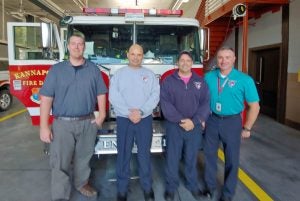Research shows effectiveness of new hazard training for firefighters
East Carolina University graduate Don Gray Jr. can list the duties firefighters routinely perform with ease. After all, he is a fire inspector and investigator with the Kannapolis Fire Department.
“Fire suppression, traffic accidents, hazardous materials mitigation, confined space rescues, high angle rescues, earthquakes, plane crashes, violent storm response, structural collapse, explosions, mass casualty events and emergency medical services,” he said.
Gray said while firefighters are routinely trained in such matters, they are not excessively trained to observe and recognize potential hazards when responding to scenes.

Dr. Dylan Hardison, left, assistant professor in the Department of Technology Systems, and Don Gray Jr., fire inspector and investigator with the Kannapolis Fire Department, had research published showing the effectiveness of energy-based hazard recognition training among firefighters.
That was the focus of research he and Dr. Dylan Hardison, assistant professor in the Department of Technology Systems, completed. Through that research, Gray became the first student in ECU’s Master of Science in Occupational Safety program to achieve peer-reviewed publication of his master’s practicum work in the journal Safety Science.
“Honestly, I had no idea that I was the first,” said Gray, who graduated last May. “With all of the great work being undertaken, I hope there are many more practicum papers from ECU’s MSOS program published in the future. I am very proud that this research may serve to provide others an opportunity to expand upon and improve the hazard recognition process within any given profession. I am very thankful for the opportunity to have participated in this study and proud that Safety Science deemed this research relevant enough to publish.”
The research focused on the implementation and effectiveness of energy-based hazard recognition training. Hardison said the method allows firefighters to characterize safety hazards in their environment by using 10 sources of energy as a classification system such as gravity, motion, electrical or mechanical. Using the method, firefighters can more efficiently classify a hazardous condition and quickly identify a communication, mitigation and avoidance strategy — all with the goal to increase safety.
Hardison and Gray developed and then taught the safety training to 43 firefighters across eastern North Carolina, with participants showing a 21 percent increase in hazard recognition from tests done before the training to after the training. Hardison said assessments given three months later revealed the training method affects firefighters’ long-term memory and hazard recognition skill as well.
“This is the first known quasi-experimental test of a hazard recognition strategy within the fire service industry with appropriate controls that optimize validity and statistical rigor,” said Hardison, who is also a volunteer firefighter for the Sand Hill Fire Department in Kinston. “The current work implies that energy-based hazard recognition training can significantly affect firefighters’ abilities to anticipate hazardous conditions on the fire grounds and training environments. Specifically, the effectiveness of energy-based hazard recognition training must be exposed to the industry through both voluntary and standardized trainings. This is especially important as the findings suggest that firefighter experience may not be a sole indicator of hazard recognition capability and those exposed to this hazard recognition method may be able to identify hazards in which those without the training may overlook.”

Dr. Dylan Hardison, left, stands with members of the Kannapolis Fire Department, from left, Capt. Jeremy Brown, firefighter Hugh Barnes, and fire inspector and investigator Don Gray. (Contributed photo)
The training is being developed to deliver on a volunteer basis to fire departments in Lenoir and Pitt counties.
“The training program that Dr. Hardison and I created provides firefighters another tool that when used may assist those firefighters when responding to an emergency to improve each individual’s situational awareness by recognizing hazards and provide a way to express and communicate to others those hazards encountered,” Gray said.
Gray said he was looking to further his education with a master’s degree and found ECU’s occupational safety program would work well with his current job duties.
“My job as a fire inspector exists to protect the public by performing inspections on new and existing buildings for compliance with local fire laws, codes and ordinances, and to assist with fire and safety educational programs,” Gray said. “Essentially, my career places me within businesses, factories, construction sites, assembly occupancies, etc., and with an education in occupational safety I can relate to those working in those environments while representing the fire department and enforcing fire code regulations.”
He also plans on sharing what he learned while working on the research with his fellow members of the Kannapolis Fire Department.
“Working on this project was challenging and extensive, but very rewarding,” Gray said.
— By Ken Buday